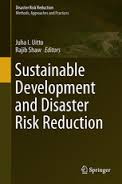Sustainable Development and Disaster Risk Reduction

The relationship among sustainable development, disaster risk management and climate change adaptation has not been treated in depth by many international institutions, national governments and localities in the past 20 years. This can be seen in all the different agencies and entities working on each issue separately.
In 2015 the United Nations released the Sustainable Development Goals (SDGs), which showed the inclusion of disaster risk reduction and resilience in different matters. Sustainable Development and Disaster Risk Reduction highlights the benefits for communities and countries when working with one management strategy integrating disaster risk reduction (DRR), climate change adaptation (CCA), and sustainable development (SD).
The editors present linkages among DRR, CCA, and SD, considering urban areas exposed to natural hazards and climate change. Such areas include those where it is necessary to have more holistic vulnerability assessments, including the promotion of resilience (Hue City Vietnam, Chapter 4). They also include coastal areas where it is necessary for sustainable development to integrate aspects including environmental pollution control; ecosystem carrying capacity valuation; resilience, risk and vulnerability mapping; land use planning; human capacity development; eco-friendly policies; and ecosystem restoration (Chapter 10).
General topics such as food security, agriculture and water access, and health are analysed (Chapters 6, 7 and 12), in light of the impacts of climate change and disasters. This should strengthen integrated management, protection, research, implementation of adaptation strategies, vulnerability reduction, and planning, among others.
Environmental aspects are particularly recognized in the book. These include: the recognition of ecosystem management practices associated with DRR (chapter 8); the importance of concerted basin plans (Murray-Darling Basin in Australia, Chapter 11); and forestry and the ways it is assessed (Chapter 15).
Social elements are alos covered, with 10 different examples of community-based risk reduction. These are related to the different development issues in rural and urban areas (Japan, Sri Lanka, Bangladesh and India, Chapter 13); and the relevance of indigenous knowledge to disaster risk reduction and management policies for sustainable development (the Agta group in Casiguran, Philippines, Chapter 16).
Additionally, some contributors to this compilation recognize education as a particular activity to integrate DRR, CCA and SD. Authors review the achievements of the UN Decade for Sustainable Development in the area of disaster risk reduction education (Chapter 14), and mention the Sustainability Literacy Test, as a tool to measure the minimum-level knowledge of economic, social and environmental responsibility for higher education students (Chapter 17).
As a conclusion, the conjuncture of new international agreements for sustainable development (Rio+20 – 2012, Sustainable Development Goals – 2015), disaster risk reduction (Sendai Framework – 2015), and climate change (IPCC – 2014, COP 21 – 2015) is highlighting the importance of improving management by connecting these issues. There are many activities that need to be implemented, and this book presents a number of ways to go in this direction.
Book note prepared by Dora Catalina Suárez
Search the Book notes database
Our Book notes database contains details and summaries of all the publications included in Book notes since 1993 - with details on how to obtain/download.
Use the search form above, or visit the Book notes landing page for more options and latest content.
For a searchable database for papers in Environment and Urbanization, go to http://eau.sagepub.com/

